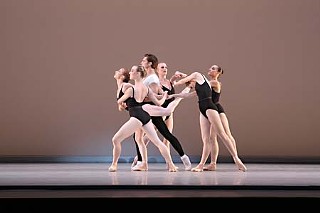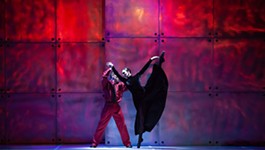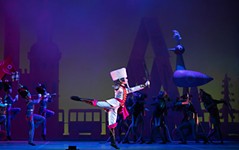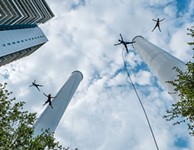Balanchine, by the Muse
Working with the Suzanne Farrell Ballet, Ballet Austin gets in step with history
By Jonelle Seitz, Fri., Oct. 24, 2008

The orchestra conductor sounds as if he's plucking notes out of an atmosphere denser than Earth's. The men and women onstage, wearing black and white leotards and tights, gingerly begin to move together as if propelled by the forces of the sound. "Is this ballet?" some in their plush seats undoubtedly wonder. Of course. It's a ballet by George Balanchine, who, more than any other, was responsible for the neoclassical ballet of the 20th and 21st centuries.
Balanchine (1904-1983) choreographed hundreds of ballets, as well as dances, for films, operas, and musicals in his lifetime. Many of his ballets are in the repertory of ballet companies large and small all over the world; some were lost or abandoned forever after their premieres. Few of his ballets share the reception of "Episodes," which has both perplexed dance-goers and left them wanting more – presumably so they can have another stab at defining it.
The most recent opportunity to do so was two weeks ago, when Ballet Austin performed the work in a joint venture with the Suzanne Farrell Ballet, based in Washington, D.C., at the Kennedy Center's 1,100-seat Eisenhower Theater. This weekend, the two companies will convene once again to perform the ballet as part of Ballet Austin's season-opening triple bill at the Long Center.
"Episodes," which premiered in 1959, is danced to several pieces by Anton Webern, whose music is not exactly easy listening. Ballet Austin Artistic Director Stephen Mills has clear memories of the first time he saw ballet, a quarter-century ago. "It was around 1982 or '83," he said via telephone from Washington on the morning of the Kennedy Center opening. "I was in New York, and I saw two performances of "Episodes" in a week, and it was really very striking to me. The music is very unusual, very dissonant, but in typical Balanchine fashion, he was able to structure the movement in a way that you can see the music. Webern, for most people, is difficult to sit down and listen to, but with a dance structure on top of it, it becomes so clear and very enjoyable."
Austin audiences will get to see the ballet because of a recent initiative by the Washington company. The Suzanne Farrell Ballet resides at the Kennedy Center as a sort of upscale pickup company focused on performing the works of Balanchine, especially those that have been rarely performed. Farrell, who was George Balanchine's muse and a prima ballerina of world renown, makes ends meet on a smaller budget by rounding up dancers from other companies several times a year. This setup creates some interesting puzzles in scheduling and repertory.
To enable the company to perform ballets that require more than a dozen or so dancers, last year Farrell began her Artistic Partnership initiative. "There is so much good work that companies are doing in their own communities," she said, speaking by phone from her Washington office a few days before flying to Austin for the Long Center performances. "I wanted to salute that and support them." Last year, dancers from the Cincinnati Ballet – based in the hometown she left almost half a century ago – joined her to perform "Chaconne."
Farrell and Mills, citing mutual interest, made contact last spring about working together for the second partnership. The deal was sealed last April when Farrell visited the Long Center and Ballet Austin's studios, choosing 13 Ballet Austin dancers to join her own group to perform "Episodes." The same number of Farrell's dancers will perform with Ballet Austin this weekend.
With this initiative, Farrell is facilitating a lot of ballet-related sharing across the United States. In addition to making possible the performance of bigger pieces in Washington, the initiative allows those pieces to get an audience in a second locale, one outside the big-city ballet hubs.
The dancers get to work intensively with Farrell, now a sought-after master teacher and coach, in rehearsal. "I think the most beneficial part about it for the dancers is spending time in the studio with Suzanne," says Mills. Though Farrell was still a student when Episodes premiered – she joined the New York City Ballet in 1961 at the age of 16 – she danced the ballet in subsequent performances. She remembers being "sort of thrown into" the second movement of the ballet to replace another dancer at the last minute. This fall, she coached Ballet Austin's Allisyn Paino in that role for both the Washington and Austin performances.
But it's not just the dancers who are learning in the studio. Mills, as a choreographer himself, sees any staging of a Balanchine ballet as a valuable opportunity to learn about craft. "I free up everything I'm doing in the office, and I sit in the studio. It's just like somebody who is interested in engines – you know, taking it apart, looking at it, putting it back together. For me, that's what watching Balanchine's ballets is like."
Balanchine, who was born in Russia and arrived in New York in 1933, took ballet in a direction in which it may have already been going, only he took it there in a speeding taxi. He used the techniques and styles he learned from the Russian masters at home and made them faster, more streamlined, and lighter. His dancers were tall and lean; he instructed them to land from jumps lightly, like cats, on the balls of their feet. He wanted his dancers to take risks, and he was known for praising dancers when they crashed to the floor – that meant they were pushing themselves out of their comfort zones. Some say he was a musical genius, and many of his dances are simply about the music, sans narrative. In order to better understand Webern's music for "Episodes," he adapted it for piano and simply played it himself.
He was introduced to Webern's music by the composer Igor Stravinsky, with whom Balanchine worked for much of his life. He became intrigued by Webern's work within the 12-tone structure, in which all notes of the chromatic scale are treated equally within the piece. Balanchine invited Martha Graham, the Great Mother of modern dance, to collaborate on a ballet to Webern's music, foreshadowing the two choreographers' immeasurable influences on 20th century dance. The result was "Episodes."
It didn't turn out to be much of a collaboration, though: Working in separate studios, Graham choreographed the first half and Balanchine the second, resulting in pieces that were independent of each other in spirit and concept. Graham's section, a dance-dramatization of the life of Mary, Queen of Scots, hasn't been performed since. Balanchine's half was about the music, and after the premiere, he reworked it as a four-movement stand-alone ballet. People often describe dance as either "narrative" or "movement for movement's sake"; "Episodes" is, in fact, movement for music's and movement's sake. The dancing isn't simply accompanied by the orchestra. It is an emanation of the music, which Balanchine said "fills the air like molecules."
Though Ballet Austin has several other Balanchine ballets in its repertoire, "Episodes" is quite different in tone, says Mills, which can be partially explained by the time in which it was made. "It's kind of Twilight Zone-y and filled with the anxiety that was coming in the early Sixties," he says. "It's hauntingly beautiful." There are no sparkly tutus in this otherworld: The costumes, pretty much the simplest possible, are the same practice clothes you'd see in any ballet school. But Farrell warns against categorizing the ballet based on its costuming. "In Mr. Balanchine's repertoire, there are several ballets that are in leotard costumes, and some people tend to think they are all the same, but they are not," she says. "You could never mistake Stravinsky's 'Agon' [1957] for Webern's 'Episodes.'"
With less than two weeks' rehearsals together before the ballet opened in Washington (on a mixed bill that also included Balanchine's "Liebeslieder Walzer" and "Ragtime" performed by the Farrell dancers), the dancers learned the piece in just three days. The rest of the rehearsal period was focused on style – especially important when folks from different companies and backgrounds come together. And although Ballet Austin dancers train every day in a style derived from Balanchine technique, each ballet poses unique challenges.
In "Episodes," there are no characterizations to understand – the dancers don't draw on backstories like "I'm a maiden who has been turned into a swan by an evil force, so I do mournful battements here." Rather, Farrell works to help the dancers achieve an understanding of motivation based on the music. Webern's music highlights instruments not featured in more typical orchestral works, and Farrell believes the dancers' movements should reflect that. "One should react differently if it's a brass instrument or if it's a violin – different instruments produce sound in a different time frame," she says.
Farrell avoids using video footage to help the dancers learn, preferring instead to explain each movement as if it were a fresh concept. "I feel that dancers should learn it from inside out, not from outside in," she explains, "because when you are a dancer, you perform out, you give out to the audience so the audience can take in what you give. If you are looking constantly into the mirror or at a video, you become a spectator instead of a performer." She sees the fact that "Episodes" is not often performed as "a gift" in the sense that the dancers have the opportunity to make the ballet their own, without the influence and stigma of past interpretations.
While Ballet Austin dancers performed only "Episodes" in Washington, this weekend they will have to switch gears backstage, as two other ballets by very different choreographers sandwich "Episodes" in the inaugural program. Twyla Tharp's ballroom-inspired crowd-pleaser "Nine Sinatra Songs" will begin the evening, and Mills' brand-new, energetic "Liminal Glam," to music by Philip Glass, is the scheduled finale. ("The costumes are just so hot!" Mills promises of his new ballet.)
But other than the differences in programming, both Mills and Farrell say that the Austin audience will see pretty much the same "Episodes" that Washingtonians did. Except, Farrell notes, that whatever nuances unfold in the Austin Symphony Orchestra's treatment of Webern will affect the dancing. While seeing dance and live music unfold together is always exciting, "Episodes" is particularly responsive to the music. "No two performances are the same," says Farrell.
Reviews of the Washington performance of "Episodes" were brief and dismissively favorable, choosing to focus on other parts of the program, but critics have sometimes bemoaned the Farrell company's inability to attract dancers that match up to her own prima ballerina status. "If Farrell had the dancer excellence to match her vision," wrote Sarah Kaufman of The Washington Post, "we wouldn't be talking about five days in the Eisenhower; there would be a grander unveiling in the Opera House and an international tour."
Nevertheless, Farrell, who was revealed as an inspiring master teacher in the 1990s with her intensive workshops for students, is known for drawing out of dancers that certain je ne sais quoi. "They perform with rare freshness and nuance," New York Times chief dance critic Alastair Macaulay wrote of Farrell's dancers. "Audiences regularly see much more distinguished dancers give performances of far less understanding and authority than these."
More important than critics, though, are audiences, and Farrell certainly has one for her company at the Kennedy Center. "I was not surprised but very happy," she says about the audience's response to "Episodes." "You know, it's the kind of ballet that requires participation from the audience, where they're on the edge of their seat, not sitting back and just observing."
Though she wonders if anyone in Austin has heard of this ballet, she's characteristically optimistic about the Long Center performances. "I think it'll look terrific there," she says. "It's really a happy challenge for everybody."
Ballet Austin's Inaugural Season Opener runs Oct. 24-26, Friday & Saturday, 8pm; Sunday, 3pm, at Dell Hall in the Long Center, 701 W. Riverside. For more information, call 476-2163 or visit www.balletaustin.org.











